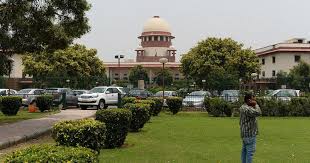Feature
SC rejects petition opposing juvenile release in Nirbhaya case

New Delhi: The Supreme Court today rejected the petition by the Delhi Commission for Women (DCW) against the release of juvenile convict in Nirbhaya gang-rape case.
The family of the young woman who was brutally gang-raped said it will continue its fight for justice.
“We share your concern,” an apex court’s vacation bench of Justice A.K. Goel and Justice U.U. Lalit said, while dismissing the plea filed by the Delhi Commission for Women.
The convict in the Nirbhaya gang-rape case, who is now 20 years old, was a juvenile when he committed the heinous crime in 2012 along with his friends in a moving bus in the national capital.
He was tried under the Juvenile Justice Act and ordered to be kept in a remand home for three years. He was released on December 20.
Delhi Commission for Women chief Swati Maliwal, who filed the plea in the apex court for a halt on his release, said the (central) government had failed the women of the country.
“The government has failed the women of the country… It is a dark day for the entire nation,” Maliwal told the media outside the Supreme Court.
“The time for candle marches is over; it is now time for women to take up ‘mashaal’ (torchlight),” she added.
The deceased rape victim’s mother expressed dissatisfaction over the Supreme Court ruling on Monday, saying such verdict will encourage crime against women in society.
“All I have to say is that the plea, which was rejected by all three courts, will encourage more such crimes to be committed in society against women.”
“There is no provision (to convict juveniles) or to punish them. They (courts) are more concerned about the accused. Women have been cheated and they continue to be cheated. Nobody wants to do anything on women’s safety,” Nirbhaya’s mother said after the verdict.
“I will continue to fight to bring changes in the law,” she said.
“Let’s see what happens in the future. As of now only one convict has been released. There are four more convicts. I appeal to the Supreme Court that although the juvenile has been released since there is no provision to convict him further, please convict them (other four) and hang them and give justice to Nirbhaya,” she added.
Entertainment
Meghalaya Reserves Legalized Gambling and Sports Betting for Tourists

The State Scores Extra High on Gaming-Friendly Industry Index
Meghalaya scored 92.85 out of 100 possible points in a Gaming Industry Index and proved to be India’s most gaming-friendly state following its recent profound legislation changes over the field allowing land-based and online gaming, including games of chance, under a licensing regime.
The index by the UK India Business Council (UKIBC) uses a scale of 0 to 100 to measure the level of legalisation on gambling and betting achieved by a state based on the scores over a set of seven different games – lottery, horse racing, betting on sports, poker, rummy, casino and fantasy sports
Starting from February last year, Meghalaya became the third state in India’s northeast to legalise gambling and betting after Sikkim and Nagaland. After consultations with the UKIBC, the state proceeded with the adoption of the Meghalaya Regulation of Gaming Act, 2021 and the nullification of the Meghalaya Prevention of Gambling Act, 1970. Subsequently in December, the Meghalaya Regulation of Gaming Rules, 2021 were notified and came into force.
All for the Tourists
The move to legalise and license various forms of offline and online betting and gambling in Meghalaya is aimed at boosting tourism and creating jobs, and altogether raising taxation revenues for the northeastern state. At the same time, the opportunities to bet and gamble legally will be reserved only for tourists and visitors.
“We came out with a Gaming Act and subsequently framed the Regulation of Gaming Rules, 2021. The government will accordingly issue licenses to operate games of skill and chance, both online and offline,” said James P. K. Sangma, Meghalaya State Law and Taxation Minister speaking in the capital city of Shillong. “But the legalized gambling and gaming will only be for tourists and not residents of Meghalaya,” he continued.
To be allowed to play, tourists and people visiting the state for work or business purposes will have to prove their non-resident status by presenting appropriate documents, in a process similar to a bank KYC (Know Your Customer) procedure.
Meghalaya Reaches Out to a Vast Market
With 140 millions of people in India estimated to bet regularly on sports, and a total of 370 million desi bettors around prominent sporting events, as per data from one of the latest reports by Esse N Videri, Meghalaya is set to reach out and take a piece of a vast market.
Estimates on the financial value of India’s sports betting market, combined across all types of offline channels and online sports and cricket predictions and betting platforms, speak about amounts between $130 and $150 billion (roughly between ₹9.7 and ₹11.5 lakh crore).
Andhra Pradesh, Telangana and Delhi are shown to deliver the highest number of bettors and Meghalaya can count on substantial tourists flow from their betting circles. The sports betting communities of Karnataka, Maharashtra, Uttar Pradesh and Haryana are also not to be underestimated.
Among the sports, cricket is most popular, registering 68 percent of the total bet count analyzed by Esse N Videri. Football takes second position with 11 percent of the bets, followed by betting on FIFA at 7 percent and on eCricket at 5 percent. The last position in the Top 5 of popular sports for betting in India is taken by tennis with 3 percent of the bet count.
Local Citizens will Still have Their Teer Betting
Meghalaya residents will still be permitted to participate in teer betting over arrow-shooting results. Teer is a traditional method of gambling, somewhat similar to a lottery draw, and held under the rules of the Meghalaya Regulation of the Game of Arrow Shooting and the Sale of Teer Tickets Act, 2018.
Teer includes bettors wagering on the number of arrows that reach the target which is placed about 50 meters away from a team of 20 archers positioned in a semicircle.
The archers shoot volleys of arrows at the target for ten minutes, and players place their bets choosing a number between 0 and 99 trying to guess the last two digits of the number of arrows that successfully pierce the target.
If, for example, the number of hits is 256, anyone who has bet on 56 wins an amount eight times bigger than their wager.





















